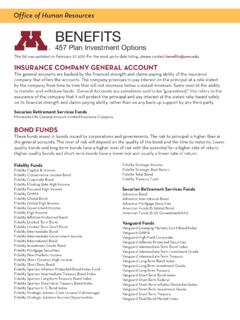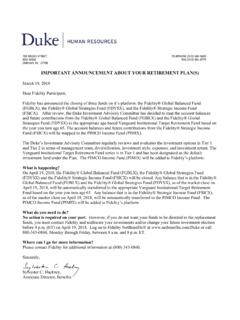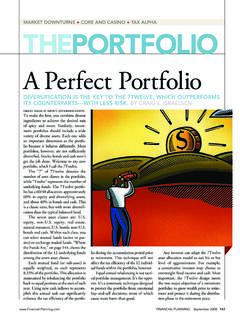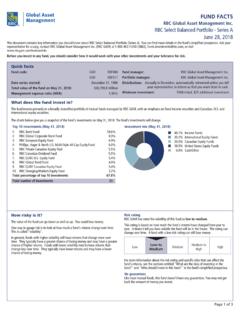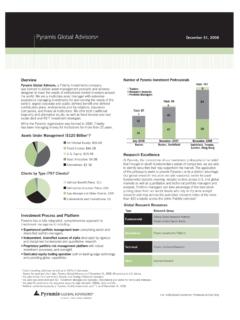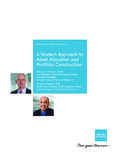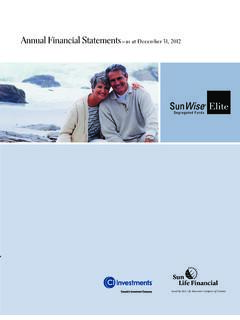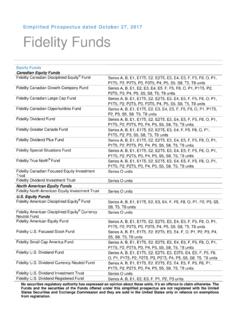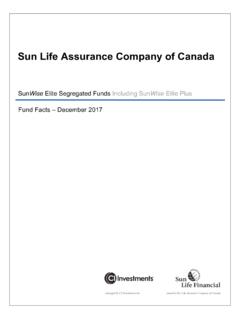Transcription of Fidelity Advantage Portfolio Fund
1 ORSO. Fidelity Advantage Portfolio fund Annual Report December 2017. Fidelity Advantage Portfolio fund . YEAR ENDED 31ST DECEMBER 2017. ANNUAL REPORT. Contents Pages Management and Administration 1. Report of the Investment Manager 2 7. Report of the Trustee to the Unitholders 8. Independent Auditor's Report 9 12. Statement of Net Assets 13 26. Statement of Comprehensive Income 27 40. Statement of Changes in Net Assets Attributable to Unitholders 41 54. Statement of Cash Flows 55 68. Notes to the Financial Statements 69 135. Schedule of Investments (Unaudited) 136 187. Investment Portfolio Movements (Unaudited) 188 201. Performance Table (Unaudited) 202 207. Fidelity Advantage Portfolio fund 1.
2 YEAR ENDED 31ST DECEMBER 2017. MANAGEMENT AND ADMINISTRATION. Investment Manager FIL Investment Management (Hong Kong) Limited Level 21, Two Pacific Place, 88 Queensway, Admiralty, Hong Kong Trustee and Registrar HSBC Institutional Trust Services (Asia) Limited 1 Queen's Road Central Hong Kong Auditor PricewaterhouseCoopers 22nd Floor, Prince's Building, Central, Hong Kong Legal Advisers Deacons 5th Floor Alexandra House 18 Chater Road Central Hong Kong Fidelity Advantage Portfolio fund 2. YEAR ENDED 31ST DECEMBER 2017. REPORT OF THE INVESTMENT MANAGER. Annual Report As at 31st December 2017. This Annual Report does not constitute an offer of units. Units are offered on the basis of the information contained in the current Explanatory Memorandum (and the documents referred to within it).
3 Copies of the current Explanatory Memorandum and latest annual report for the fund are available from the registered office of the Investment Manager or from any of the companies registered as distributors of the Fidelity Advantage Portfolio fund . Fidelity Advantage Portfolio fund 3. YEAR ENDED 31ST DECEMBER 2017. REPORT OF THE INVESTMENT MANAGER. 2017 global Market Review Consolidated Manager Report United States US equities rose over the review period, supported by the successful passage of the tax reform bill, robust economic data, strong corporate earnings and interest rate increases by the US. Federal Reserve (Fed). Most sectors generated positive returns, with information technology (IT), materials and consumer discretionary leading the market.
4 During the review period, the Fed increased its benchmark interest rate thrice, in March 2017, June 2017 and December 2017, by a total of three-quarters of a percentage point. The interest rate now ranges between and This is in line with an earlier indication of three interest rate rises in 2017. The Fed also announced that Jerome Powell will take over as the new Chairperson in February 2018, when Janet Yellen's term ends. Europe European equities posted strong positive returns over the 12-month period ending December 2017. Markets started the period on a positive note, as strong economic data from the eurozone and prospects of pro-growth policies by US President Donald Trump's government boosted investor sentiment.
5 Equities were also supported by the Dutch election results, where voters rejected a populist candidate. The victory of centrist candidate Emmanuel Macron in the French presidential election in May 2017 helped reduce political risk in Europe, which further supported equities. However, there was some volatility in June as investors misinterpreted European Central Bank (ECB) President Mario Draghi's remarks on economic expansion and easing deflationary pressures as a sign that the central bank would reduce monetary stimulus. The ECB later clarified that it would retain its accommodative monetary policy stance. Markets were volatile at the start of the third quarter of 2017 due to rising geopolitical tensions, but rebounded in September as macroeconomic data and surveys confirmed the momentum in the economic recovery.
6 The year ended on a positive note, driven by the ECB's continued accommodative monetary policy stance, strong corporate earnings and sustained global economic growth. Furthermore, the passage of the US tax reform bill boosted investor sentiment. All sectors posted positive returns, with cyclicals outperforming defensives. IT, materials and industrials were the top performing sectors, while telecommunication services, energy and health care stocks underperformed the broader market. Japan Japanese equities rose strongly in local currency terms over the year, backed by upbeat corporate earnings results, easing political concerns and a steady flow of positive economic data.
7 Prime Minister Shinzo Abe's landslide victory in the snap general election held in late October provided further momentum amid hopes of a continuation of Abenomics (economic policies advocated by Abe). Stocks started the year on a positive note amid robust global macroeconomic indicators and upbeat corporate earnings results. Expectations that the Trump administration's reflationary policies would boost US and global growth also supported gains. However, sentiment waned as mounting concerns about external political risks put upward pressure on the yen. Equities rebounded from mid-April as upbeat earnings results, easing political concerns and a steady flow of positive economic data spurred gains.
8 Investor confidence increased as a combination of export, domestic, defensive and commodity related companies contributed to a pickup in earnings growth. Meanwhile, attractive relative valuations and healthy growth momentum supported inflows from overseas investors. There were periods of diminished risk sentiment owing to North Korea's ballistic missile launches and accompanying political rhetoric. The strong rise in Japanese markets in 2017 was also backed by two US-related factors; the sharp rise in US long-term rates and a stronger US dollar. In terms of style, growth companies outperformed value stocks, while Fidelity Advantage Portfolio fund 4. YEAR ENDED 31ST DECEMBER 2017.
9 REPORT OF THE INVESTMENT MANAGER. 2017 global Market Review Consolidated Manager Report (Continued). Japan Japanese equities rose strongly in local currency terms over the year, backed by upbeat corporate earnings results, easing political concerns and a steady flow of positive economic data. Prime Minister Shinzo Abe's landslide victory in the snap general election held in late October provided further momentum amid hopes of a continuation of Abenomics (economic policies advocated by Abe). Stocks started the year on a positive note amid robust global macroeconomic indicators and upbeat corporate earnings results. Expectations that the Trump administration's reflationary policies would boost US and global growth also supported gains.
10 However, sentiment waned as mounting concerns about external political risks put upward pressure on the yen. Equities rebounded from mid-April as upbeat earnings results, easing political concerns and a steady flow of positive economic data spurred gains. Investor confidence increased as a combination of export, domestic, defensive and commodity related companies contributed to a pickup in earnings growth. Meanwhile, attractive relative valuations and healthy growth momentum supported inflows from overseas investors. There were periods of diminished risk sentiment owing to North Korea's ballistic missile launches and accompanying political rhetoric. The strong rise in Japanese markets in 2017 was also backed by two US-related factors; the sharp rise in US long-term rates and a stronger US dollar.

